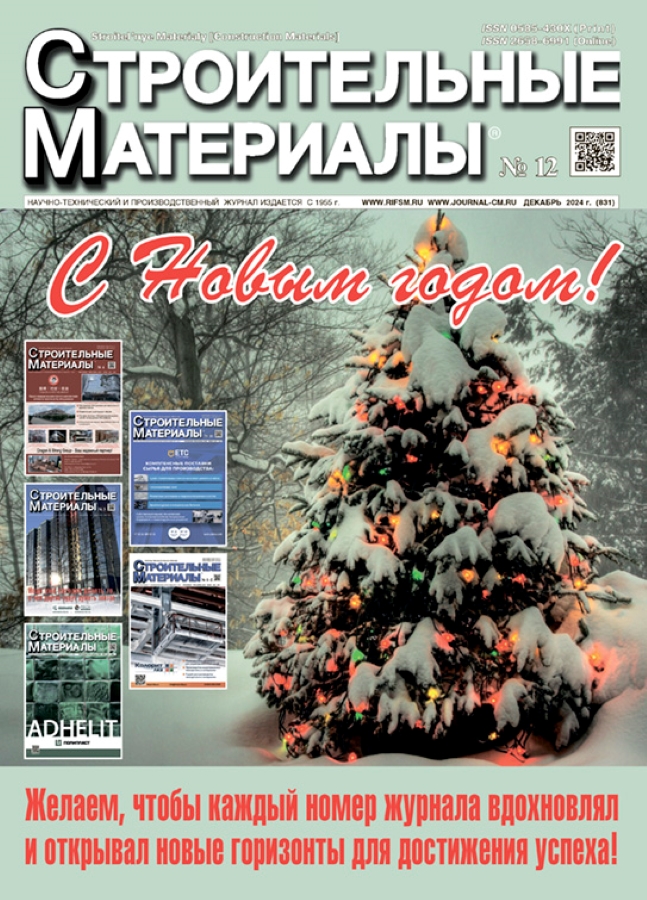Modeling of indicators of competitive materials for the manufacture of formwork in the construction of industrial buildings
- Autores: Fedotov A.A.1, Vakhnina T.N.1, Susoeva I.V.1, Titunin AA1
-
Afiliações:
- Kostroma State University
- Edição: Nº 12 (2024)
- Páginas: 68-72
- Seção: Статьи
- URL: https://cardiosomatics.ru/0585-430X/article/view/646349
- DOI: https://doi.org/10.31659/0585-430X-2024-831-12-68-72
- ID: 646349
Citar
Texto integral
Resumo
The article presents the results of an experimental substantiation of the production of plywood for construction purposes under conditions of low-temperature pressing and reduced binder consumption. Cost reduction while maintaining performance refers to the competitive advantages of the material. One of the ways to solve this problem is to significantly reduce the temperature of hot pressing plywood (below 100оC) and reduce resin consumption (less than 100 g/m2). The study implemented a second-order B-plan and developed regression models of the dependencies of the mechanical parameters of plywood on the pressing temperature, resin consumption and the proportion of additive modifiers – aluminum chloride and magnesium chloride. The decrease in the strength when splitting plywood on an unmodified phenol-formaldehyde binder is due to the low degree of polycondensation of the binder during low-temperature pressing. Rational values of the factors of the plywood production process were obtained by analyzing regression mathematical models of the dependence of plywood indicators on variable factors. For plywood based on a modified binder, the results were obtained – the strength of the samples when rolling over the adhesive layer after boiling was 0.808 MPa at the following modes: pressing temperature 95оC, resin consumption 93 g/m2 and modifier consumption 0.5% by weight of the resin for samples with the addition of magnesium chloride. The results obtained can be recommended for use in the production of plywood for formwork with the required mechanical properties.
Palavras-chave
Texto integral
Sobre autores
A. Fedotov
Kostroma State University
Autor responsável pela correspondência
Email: aafedotoff@yandex.ru
Candidate of Sciences (Engineering)
Rússia, 17/11, Dzerzhinskiy Street, Kostroma, 156005T. Vakhnina
Kostroma State University
Email: t_vachnina@mail.ru
Candidate of Sciences (Engineering)
Rússia, 17/11, Dzerzhinskiy Street, Kostroma, 156005I. Susoeva
Kostroma State University
Email: i.susoeva@yandex.ru
Doctor of Sciences (Engineering)
Rússia, 17/11, Dzerzhinskiy Street, Kostroma, 156005A Titunin
Kostroma State University
Email: a_titunin@ksu.edu.ru
Doctor of Sciences (Engineering)
Rússia, 17/11, Dzerzhinskiy Street, Kostroma, 156005Bibliografia
- Valkonen M.J., Moya J.C., Lokki T. Preparation of fully bio-based sound absorbers from waste wood and pulp fibers by foam forming. BioResources. 2023. Vol. 18 (2), pp. 2657–2669. https://doi.org/10.15376/biores.18.2.2657-2669
- Balasbaneh A.T., Sher W., Wan Ibrahim M.H. Life cycle assessment and economic analysis of Reusable formwork materials considering the circular economy. Ain Shams Engineering Journal. 2024. Vol. 15 (4). https://doi.org/10.1016/j.asej.2023.102585
- Halverson M. Specifying the right plywood for concrete formwork. The construction specifier. 2017. https://www.constructionspecifier.com/specifying-right-plywood-concrete-formwork/ (Access date 15.08.2024).
- Biadała T., Czarnecki R., Dukarska D. Water resistant plywood of increased elasticity produced from european wood species. Wood Research. 2020. Vol. 65 (1), pp. 111–124. https://doi.org/10.37763/wr.1336-4561/65.1.111124
- Knob A., Sheib V. Fenol’nye smoly i materialy na ih osnove: per. s angl. A.M. Vasilenko, G.M. Voskanyanca [Phenolic resins and materials based on them: translated from English by A.M. Vasilenko, G.M. Voskanyants]. Moscow: Himiya. 1983. 280 p.
- Irzhak V.I., Mezhikovskij S.M. Himicheskaya fizika otverzhdeniya oligomerov: [Chemical physics of oligomer curing]. Moscow: Yurajt, 2022. 276 p.
- Sedliačik J., Bekhta P., Potapova O. Technology of low-temperature production of plywood bonded with modified phenol-formaldehyde resin. Wood Research. 2010. Vol. 55 (4), pp. 123–130. https://www.researchgate.net/publication/267026018_Technology_of_low-temperature_production_of_plywood_bonded_with_modified_ phenol-formaldehyde_resin
- Kawalerczyk J., Dziurka D., Mirski R., Siuda J., Sedliačik J. Microcellulose as a modifier for UF and PF resins allowing the reduction of adhesive application in plywood manufacturing. Acta Facultatis Xylologiae. 2021. Vol. 63 (2), pp. 31–38. https://doi.org/10.17423/afx.2021.63.2.03
- Ortynska G., Bekhta P., Lyutyy P., Sedliačik J. Bonding of birch veneer with high moisture content using phenol-formaldehyde resin modified by soy protein. Acta Facultatis Xylologiae. 2018. Vol. 60 (1), pp. 85–91. https://doi.org/10.17423/afx.2018.60.1.09
- Fitrianum F., Rahandi Lubis M.A., Hadi Y.S., Sari R.K., Maulana M.I., Kristak L., Iswanto A.H., Mardawati E., Reh R., Sedliačik J. Adhesion and cohesion strength of phenol-formaldehyde resin mixed with different types and levels of catalyst for wood composites. Journal of Composites Science. 2023. Vol. 7 (310). https://doi.org/10.3390/jcs7080310
- Qin Z., Teng K. Mechanical model and changed chemical structure of phenol-formaldehyde adhesive on plywood with different hot press process. The Journal of Adhesion. 2021. Vol. 98 (15), pp. 2348–2365. https://doi.org/10.1080/00218464.2021.1970545
- Fedotov A., Vahnina T., Susoeva I. Resistance to temperature and humidity changes of construction plywood and thermal-insulation boards. Magazine of Civil Engineering. 2021. Vol. 5 (105). Article No. 10506. https://doi.org/10.34910/MCE.105.6
- Chubinskij A.N., Rusakov D.S., Sokolova E.G., Varankina G.S., Fedyaev A.A. Innovative research methods for adhesive joints. Izvestiya Sankt-Peterburgskoj lesotekhnicheskoj akademii. 2023. No. 243, pp. 253–268. (In Russian) .EDN: IGKZUQ. https://doi.org/10.21266/2079-4304.2023.243.253-268
- Ivanov A.M., Rusakov D.S., Barankina G.S., Chubinskij A.N. Modification of phenol-formaldehyde resins with aluminosilicates for gluing plywood. Klei, germetiki, tekhnologii. 2017. No. 3, pp. 13–17. (In Russian). EDN: YFSXEZ
- Askadskij A.A. Fiziko-himiya polimernyh materialov i metody ih issledovaniya [Physico-chemistry of polymer materials and methods of their research]. Moscow: АСВ. 2015. 408 p.
- Novakov I.A., Radchenko F.S., Papisov I.M. Investigation of the composition of polymer-colloidal complexes of polyacrylamide and aluminum polyhydroxochloride. Vysokomolekulyarnye soedineniya. Seriya B. 2007. Vol. 49. No. 5, pp. 912–915. (In Russian). EDN: IAQZZF
- Fedosov S.V., Lazarev A.A., Cvetkov D.E. Investigation of the depth of impregnation of wood with a five percent solution of bischofite during autoclaving. Fundamental exploratory and applied research of RAACES on scientific support for the development of architecture, urban planning and the construction industry of the Russian Federation in 2022–2023. Scientific works of RAACES. In 2 volumes. Vol. 2. Moscow. 2024, pp. 483–489. EDN: WLEWPA
Arquivos suplementares











